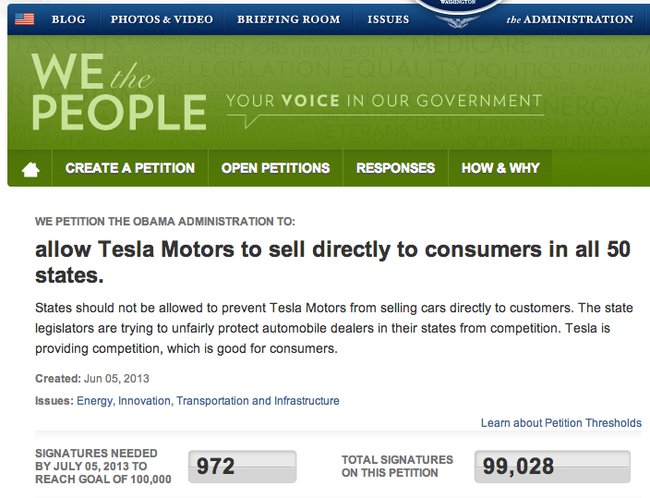News
Tesla White House Petition Response Falls on Deaf Ears
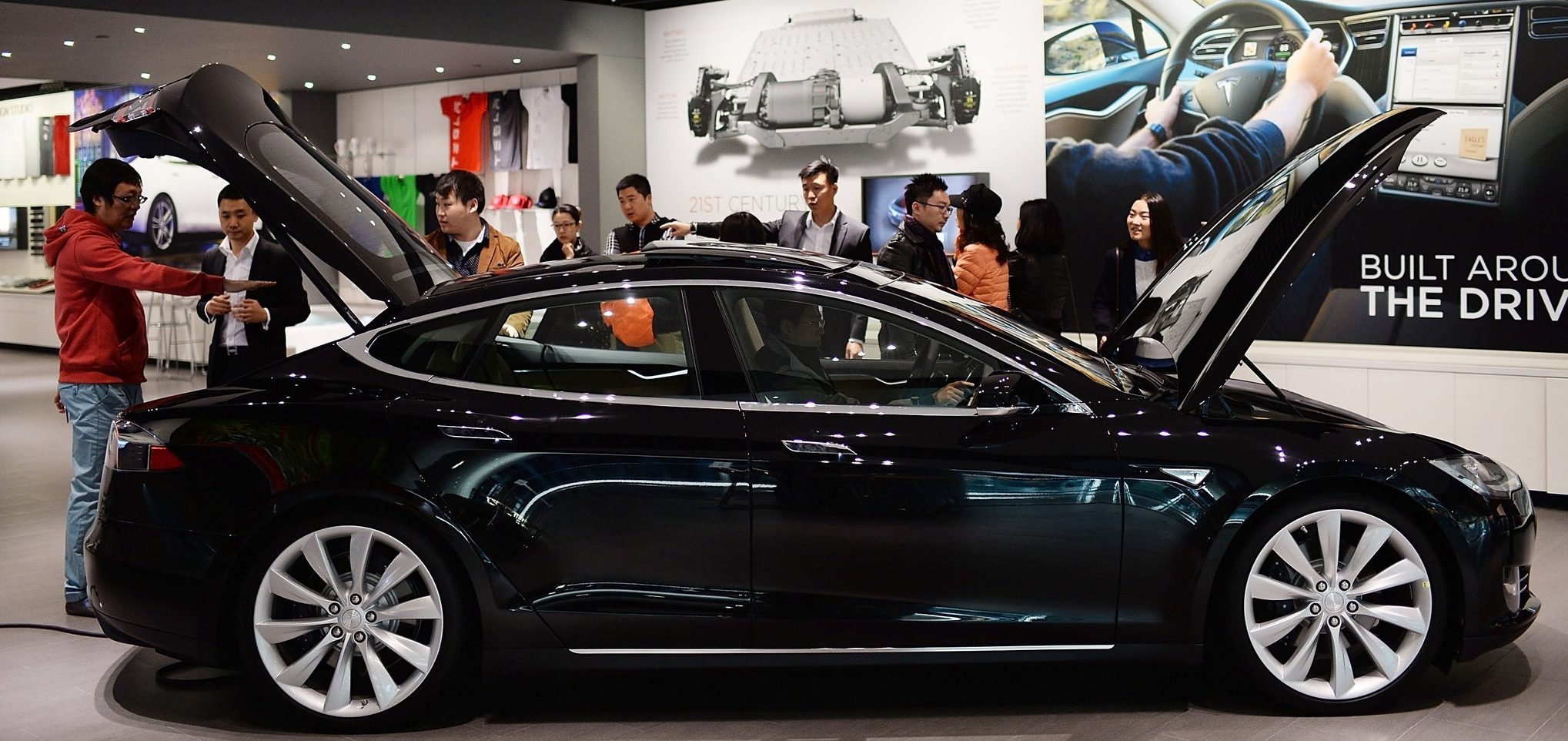
Tesla Motors direct sales proponents sent a “We the People Petition on Tesla Motors” petition to the White House asking the government to let the company sell directly to consumers. In typical modern politics, the Tesla White House response was vague, slippery and off-topic, showing once more how disconnected modern politics are from the constituent’s wishes.
Tesla White House petition response
Sometimes, the modern state of politics is enough to discourage even the most ardent liberty defender. The We the People Petition on Tesla Motors petition gathered only a few signatures, 138,469. The Tesla White House response seems to pass the bucket down. You can read the We the People Petition on Tesla Motors below. More than a year after its filing, according to ArsTechnica, the official White House response was signed by Dan Utech, Special Assistant to the President for Energy and Climate Change. The answer boils down to, it’s up to Congress to answer this matter. The call for Tesla to sell direct is now part of the left and right political maneuvers, unfortunately.
What the Tesla White House petition response asks
The Tesla White House response clearly asks to allow Tesla Motors to sell directly to consumers in all 50 states. It bases the premise on the fact most people ask for freedom of choice and that the 60 years old dealership association requirement are woefully out of date and do not represent our fast changing landscape. People want more choice and certainly, very little people can claim very positive experiences walking out of car dealerships.
What the Tesla White House petition response doesn’t answer
Utech’s Tesla White House response, goes into tangents about how the current administration has done a great job improving the choice in America and saving the environment. But it still views EV drivers as environmentalists. It’s fair to say that most Tesla drivers are more tech savvy than environmentalists. The spin Meisters response further dives and twists, avoiding to answer the petition directly. The answer hits rock bottom when it mentions: “significant progress in promoting vehicle efficiency”, talking about gasoline car, completely unrelated to the pure electric car Tesla Motors sells. To drive the point further, it states something every Tesla Motors loyalist knows by now, that the company repaid its loan nine years ahead of schedule.
This leaves us to wonder two things. Does democracy still have a place where lobbies command more decision making than what the constituents demand from their representatives, or was this befuddling answer because only 138,469 signed the petition? In the meantime, the Tesla White House response to selling directly just puts pressure on Congress.
The We the People Petition on Tesla Motors petition response
“Thanks for your We the People petition. We’re excited about the next generation of transportation choices, including the kind of electric vehicles that Tesla and others have developed. These companies are taking steps to help spur innovation in the promising area of advanced batteries and electric automobiles. Vehicle electrification and other advanced technologies are vital components of President Obama’s Climate Action Plan, and his commitment to addressing climate change and reducing carbon pollution, in addition to reducing our dependence on oil.
But as you know, laws regulating auto sales are issues that have traditionally sat with lawmakers at the state level.
We believe in the goal of improving consumer choice for American families, including more vehicles that provide savings at the pump for consumers. However, we understand that pre-empting current state laws on direct-to-consumer auto sales would require an act of Congress.
We are already making significant progress in promoting vehicle efficiency: new vehicle fuel economy has increased by 12% since 2008 and consumers now can choose from five times more car models with a combined city/highway fuel economy of 30 mpg or more, compared to just five years ago. In December 2013, the Environmental Protection Agency (EPA) announced that model year 2012 vehicles achieved an all-time high fuel economy, after increasing seven of the last eight years.
The President has taken historic action to spur more consumer choice — saving consumers money at the pump and reducing our dependence on oil. Here are some of the ways we’re helping to encourage the future generation of energy-efficient cars:
In 2012, the Obama Administration finalized groundbreaking standards that will increase fuel economy to the equivalent of 54.5 mpg for cars and light-duty trucks by Model Year 2025. These standards will save consumers more than $1.7 trillion at the gas pump and reduce U.S. oil consumption by 12 billion barrels. And this spring, we also released standards for medium- and heavy-duty trucks, a move that will save vehicle owners and operators an estimated $50 billion in fuel, and save a projected 530 million barrels of oil. You can learn more about that here.
The Department of Energy (DOE) has a loan program to help spur the kinds of innovation needed to create the future of transportation. In fact, Tesla’s electric car won the 2013 Motor Trend Car of the Year while repaying its DOE loan 9 years early and earning the taxpayers about $17 million in profit. And DOE’s loan to Ford Motor Company to upgrade 13 factories across six states and to upgrade the fuel efficiency of a dozen popular vehicles has supported 33,000 jobs across the United States.
In September 2013, DOE awarded $45 million in funding for 38 new projects that to improve fuel efficiency, lower transportation costs, and protect the environment. The 38 new projects support the goals of the EV Everywhere Grand Challenge, a public-private initiative to make EVs as affordable and convenient to own and drive as gasoline-powered vehicles within 10 years. Also as part of EV Everywhere, DOE has launched the Workplace Charging Challenge, with a goal of achieving a tenfold increase in the number of U.S. employers offering workplace charging for plug-in electric vehicles in the next five years.
As these initiatives show, the Administration is in favor of fostering competition in the market to help spur the kinds of innovation needed to support ongoing U.S. leadership in vehicle manufacturing and a potential range of new technologies.
Again, thank you for your petition.
Dan Utech is Special Assistant to the President for Energy and Climate Change”
News
Tesla UK sales see 14% year-over-year rebound in June: SMMT data
The SMMT stated that Tesla sales grew 14% year-over-year to 7,719 units in June 2025.
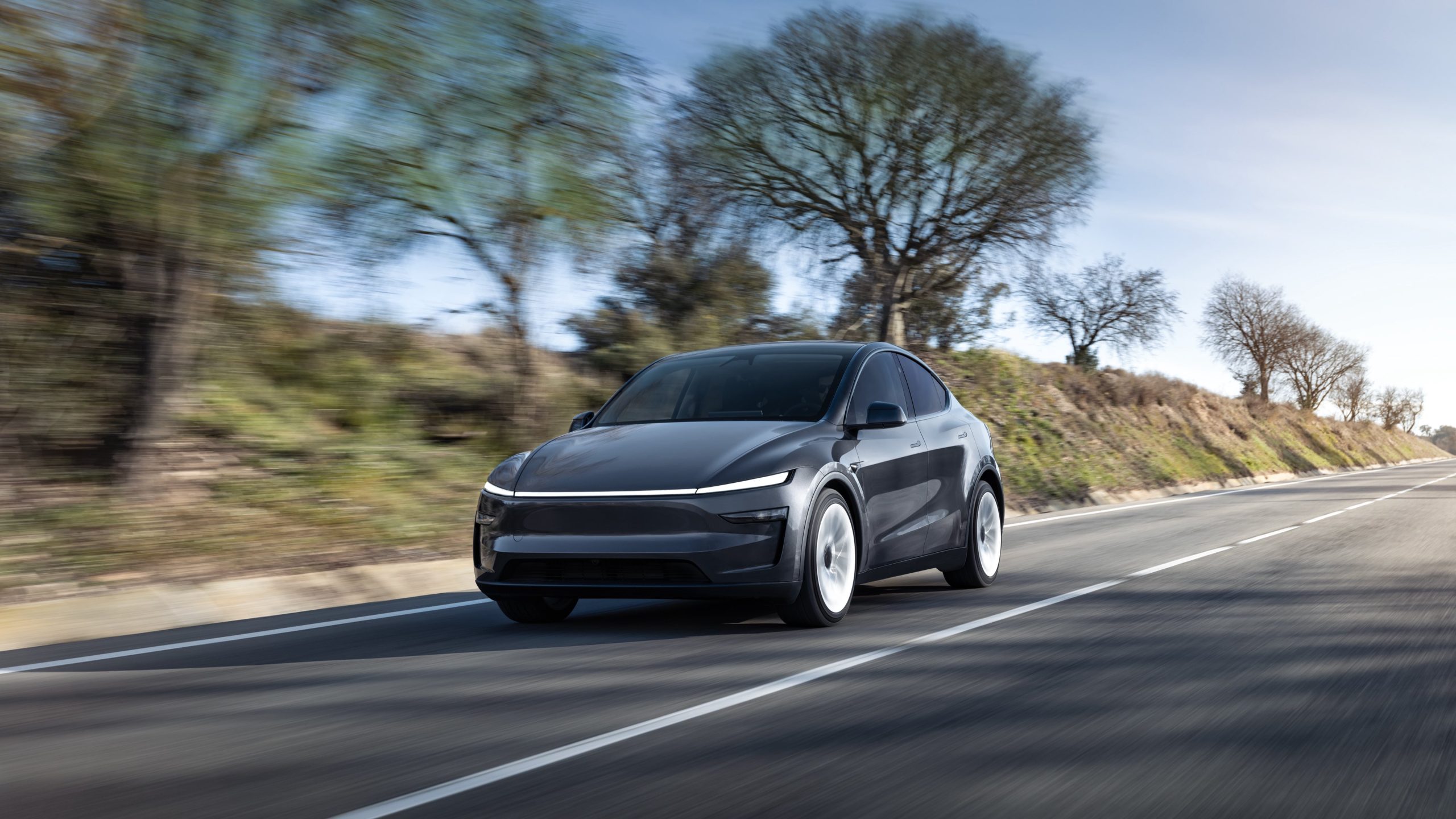
Tesla’s sales in the United Kingdom rose in June, climbing 14% year-over-year to 7,719 units, as per data from the Society of Motor Manufacturers and Traders (SMMT). The spike in the company’s sales coincided with the first deliveries of the updated Model Y last month.
Model Y deliveries support Tesla’s UK recovery
Tesla’s June performance marked one of its strongest months in the UK so far this year, with new Model Y deliveries contributing significantly to the company’s momentum.
While the SMMT listed Tesla with 7,719 deliveries in June, independent data from New AutoMotive suggested that the electric vehicle maker registered 7,891 units during the month instead. However, year-to-date figures for Tesla remain 2% down compared to 2024, as per a report from Reuters.
While Tesla made a strong showing in June, rivals are also growing. Chinese automaker BYD saw UK sales rise nearly fourfold to 2,498 units, while Ford posted the highest EV growth among major automakers, with a more than fourfold increase in the first half of 2025.
Overall, the UK’s battery electric vehicle (BEV) demand surged 39% to to 47,354 units last month, helping push total new car sales in the UK to 191,316 units, up 6.7% from the same period in 2024.
EV adoption accelerates, but concerns linger
June marked the best month for UK car sales since 2019, though the SMMT cautioned that growth in the electric vehicle sector remains heavily dependent on discounting and support programs. Still, one in four new vehicle buyers in June chose a battery electric vehicle.
SMMT Chief Executive Mike Hawes noted that despite strong BEV demand, sales levels are still below regulatory targets. “Further growth in sales, and the sector will rely on increased and improved charging facilities to boost mainstream electric vehicle adoption,” Hawes stated.
Also taking effect this week was a new US-UK trade deal, which lowers tariffs on UK car exports to the United States from 27.5% to 10%. The agreement could benefit UK-based EV producers aiming to expand across the country.
News
Tesla Model 3 ranks as the safest new car in Europe for 2025, per Euro NCAP tests
Despite being on the market longer than many of its rivals, the Tesla Model 3 continues to set the bar for vehicle safety.
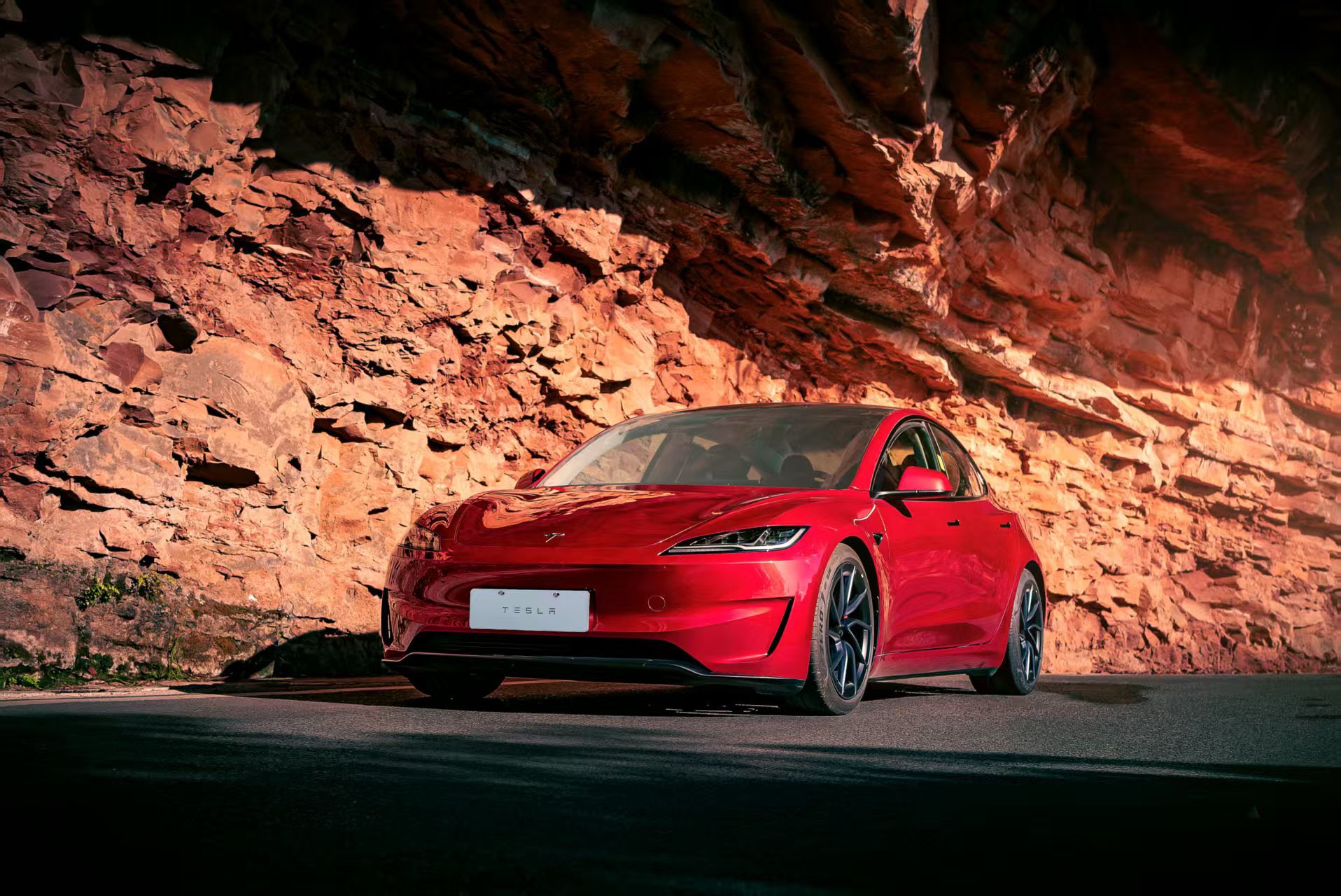
The Tesla Model 3 has been named the safest new car on sale in 2025, according to the latest results from the Euro NCAP. Among 20 newly tested vehicles, the Model 3 emerged at the top of the list, scoring an impressive 359 out of 400 possible points across all major safety categories.
Tesla Model 3’s safety systems
Despite being on the market longer than many of its rivals, the Tesla Model 3 continues to set the bar for vehicle safety. Under Euro NCAP’s stricter 2025 testing protocols, the electric sedan earned 90% for adult occupant protection, 93% for child occupant protection, 89% for pedestrian protection, and 87% for its Safety Assist systems.
The updated Model 3 received particular praise for its advanced driver assistance features, including Tesla’s autonomous emergency braking (AEB) system, which performed well across various test scenarios. Its Intelligent Speed Assistance and child presence detection system were cited as noteworthy features as well, as per a WhatCar report.
Other notable safety features include the Model 3’s pedestrian-friendly pop-up hood and robust crash protection for both front and side collisions. Euro NCAP also highlighted the Model 3’s ability to detect vulnerable road users during complex maneuvers, such as turning across oncoming traffic.
Euro NCAP’s Autopilot caution
While the Model 3’s safety scores were impressive across the board, Euro NCAP did raise concerns about driver expectations of Tesla’s Autopilot system. The organization warned that some owners may overestimate the system’s capabilities, potentially leading to misuse or inattention behind the wheel. Even so, the Model 3 remained the highest-scoring vehicle tested under Euro NCAP’s updated criteria this year.
The Euro NCAP’s concerns are also quite interesting because Tesla’s Full Self-Driving (FSD) Supervised, which is arguably the company’s most robust safety suite, is not allowed for public rollout in Europe yet. FSD Supervised would allow the Model 3 to navigate inner city streets with only minimal human supervision.
Other top scorers included the Volkswagen ID.7, Polestar 3, and Geely EX5, but none matched the Model 3’s total score or consistency across categories. A total of 14 out of 20 newly tested cars earned five stars, while several models, including the Kia EV3, MG ZS, and Renault 5, fell short of the top rating.
Elon Musk
Why Tesla’s Q3 could be one of its biggest quarters in history
Tesla could stand to benefit from the removal of the $7,500 EV tax credit at the end of Q3.

Tesla has gotten off to a slow start in 2025, as the first half of the year has not been one to remember from a delivery perspective.
However, Q3 could end up being one of the best the company has had in history, with the United States potentially being a major contributor to what might reverse a slow start to the year.
Earlier today, the United States’ House of Representatives officially passed President Trump’s “Big Beautiful Bill,” after it made its way through the Senate earlier this week. The bill will head to President Trump, as he looks to sign it before his July 4 deadline.
The Bill will effectively bring closure to the $7,500 EV tax credit, which will end on September 30, 2025. This means, over the next three months in the United States, those who are looking to buy an EV will have their last chance to take advantage of the credit. EVs will then be, for most people, $7,500 more expensive, in essence.
The tax credit is available to any single filer who makes under $150,000 per year, $225,000 a year to a head of household, and $300,000 to couples filing jointly.
Ending the tax credit was expected with the Trump administration, as his policies have leaned significantly toward reliance on fossil fuels, ending what he calls an “EV mandate.” He has used this phrase several times in disagreements with Tesla CEO Elon Musk.
Nevertheless, those who have been on the fence about buying a Tesla, or any EV, for that matter, will have some decisions to make in the next three months. While all companies will stand to benefit from this time crunch, Tesla could be the true winner because of its sheer volume.
If things are done correctly, meaning if Tesla can also offer incentives like 0% APR, special pricing on leasing or financing, or other advantages (like free Red, White, and Blue for a short period of time in celebration of Independence Day), it could see some real volume in sales this quarter.
You can now buy a Tesla in Red, White, and Blue for free until July 14 https://t.co/iAwhaRFOH0
— TESLARATI (@Teslarati) July 3, 2025
Tesla is just a shade under 721,000 deliveries for the year, so it’s on pace for roughly 1.4 million for 2025. This would be a decrease from the 1.8 million cars it delivered in each of the last two years. Traditionally, the second half of the year has produced Tesla’s strongest quarters. Its top three quarters in terms of deliveries are Q4 2024 with 495,570 vehicles, Q4 2023 with 484,507 vehicles, and Q3 2024 with 462,890 vehicles.
-

 Elon Musk5 days ago
Elon Musk5 days agoTesla investors will be shocked by Jim Cramer’s latest assessment
-

 News1 week ago
News1 week agoTesla Robotaxi’s biggest challenge seems to be this one thing
-

 Elon Musk2 weeks ago
Elon Musk2 weeks agoFirst Look at Tesla’s Robotaxi App: features, design, and more
-

 News2 weeks ago
News2 weeks agoWatch Tesla’s first driverless public Robotaxi rides in Texas
-
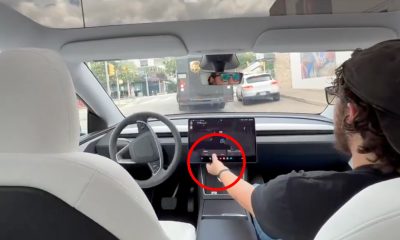
 News2 weeks ago
News2 weeks agoWatch the first true Tesla Robotaxi intervention by safety monitor
-
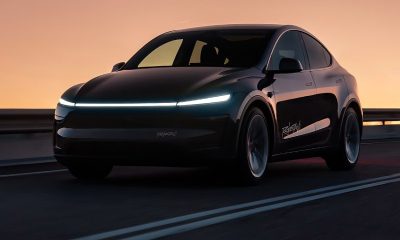
 Elon Musk2 weeks ago
Elon Musk2 weeks agoTesla officially launches Robotaxi service with no driver
-
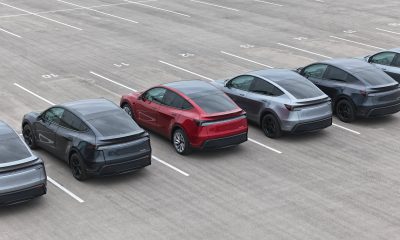
 Elon Musk1 week ago
Elon Musk1 week agoA Tesla just delivered itself to a customer autonomously, Elon Musk confirms
-

 News2 weeks ago
News2 weeks agoTesla Robotaxi rollout proves that Elon Musk still delivers, even if it’s late

